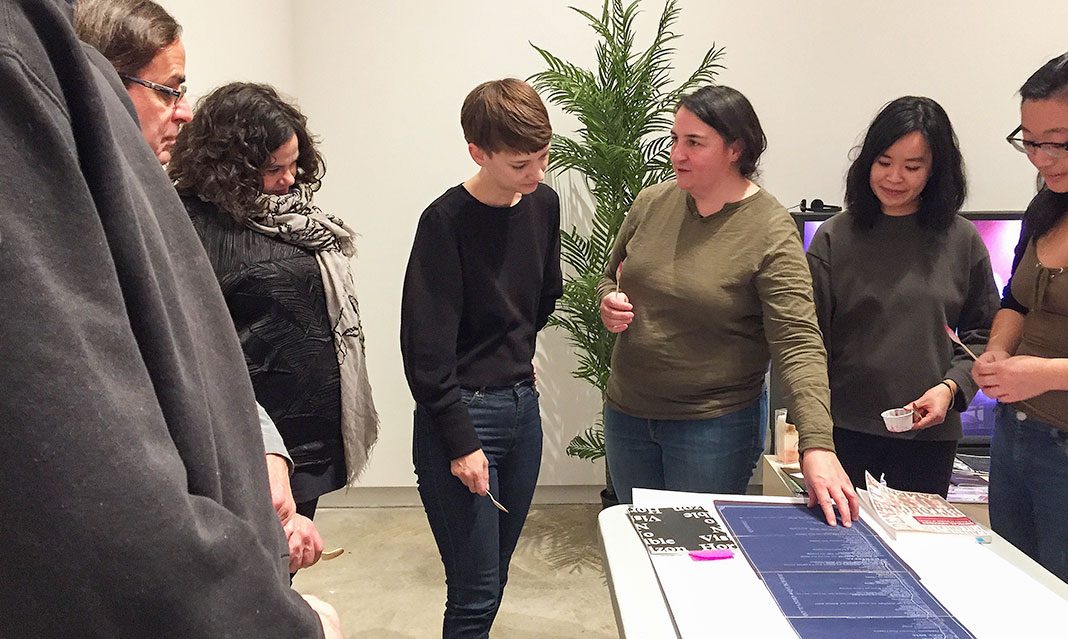In partnership with Art Metropole of Toronto, the Blackwood Gallery hosted a presentation featuring reader-in-residence Lisa Myers. Myers’ role was delivering an hour-long speech about a specific aspect of the gallery’s latest exhibition, The Sustenance Rite. In particular, Myers spoke about the Canadian Pacific Railway and included an interactive demonstration called “Playing Spoons.”
According to the pamphlet on the gallery’s latest exhibit, Myers is an “independent curator and artist with a keen interest in interdisciplinary collaboration.” Myers holds an MFA in Criticism and Curatorial Practice from OCAD University. She has also been published in FUSE, a non-profit arts magazine.
As part of the interactive demonstration titled “Playing Spoons,” Myers gave participants a wooden spoon and fresh berries contained in a ketchup cup. She later explained that the blueberries grew on her family’s farm. While Myers delivered a side anecdote about her diabetic grandfather, participants listened.
“This work of blueberries came a lot from my mother’s side. I was raised with mostly my mother’s family. My [maternal] grandfather lived in Parry Sound in an apartment. I should mention that my grandfather is diabetic,” Myers continued, “And so his sugar intake was always a concern. Whenever he went to the doctor and his sugar intake was off, my grandmother would always bear [the brunt of the scolding]. One day my family and I were at Lill’s Place, a diner, in Parry Sound, and the waitress sort of unmasked my grandfather by asking him, ‘So, Vance, do you want your usual slice of blueberry pie?’ He looked shocked, because that was where his sugar intake was spiking.”
After the participants finished eating their berries, Myers herded the group towards a table with a map depicting the expanse of the Canadian Pacific Railway in 1886. The map depicted a line reaching from Quebec to British Columbia, with labeled points of cities in between.
“At the time, this railroad was integral to bringing the Canadian nation together. In this process of bringing a nation together, putting up an infrastructure like this railroad meant the displacement of many people. Also, it meant a lot of exploitation of people,” Myers explained.
At the time of the railway’s construction, treaty negotiations between the Canadian government and the First Nations people took place. The purpose of these treaties was to secure land in order to advance the construction of the railway. Myers gave the example of Treaty 3, which was a negotiation involving the Ojibwe, concerning land rights in northwestern Ontario. Myers explained that “the spoken negotiation that the Ojibwe had agreed to was very different” from the written documentation of the negotiation.”
“So in that way, you see that there was a lot of deception and a lack of honesty in this land negotiation,” Myers said.
As an activity, Myers suggested that each participant around the table read out a few names of the cities written on the map. After the last city was read aloud, Myers asked participants to place their wooden spoons from earlier, on a city. She advised that the spoon should be placed according to a city which drew the participant’s attention in some way. Following her instructions, some participants placed their wooden spoons in places that they’ve personally traveled to or hope to visit. Other participants chose areas on the map that resembled the shape of the blueberry stains on their spoons. As a final activity, participants gathered together to share personal stories. Myers asked participants to further specify why they chose the particular location of the map to place their spoons.
This event marked the third session of the Reader-In-Residence appearance at the Blackwood Gallery.



